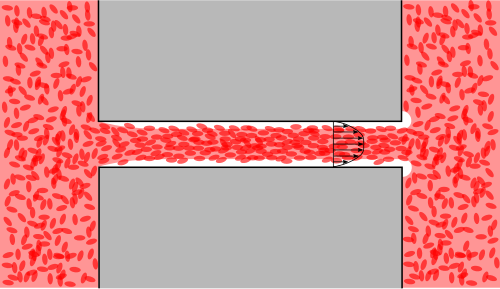Fåhræus effect

The Fåhræus effect is the decrease in average concentration of red blood cells in human blood as the diameter of the glass tube in which it is flowing decreases. In other words, in blood vessels with diameters less than 500 micrometers, the hematocrit decreases with decreasing capillary diameter. The Fåhræus effect definitely influences the Fåhræus–Lindqvist effect, which describes the dependence of apparent viscosity of blood on the capillary size, but the former is not the only cause of the latter.[1]
Mathematical model
Considering steady laminar fully developed blood flow in a small tube with radius of , whole blood separates into a cell-free plasma layer along the tube wall and enriched central core. As a result, the tube hematocrit is smaller than the out flow hematocrit . A simple mathematical treatment of the Fåhræus effect was shown in Sutera et al. (1970).[2] This seems to be the earliest analysis:
where:
- is the tube hematocrit
- is the outlet hematocrit
- is the cell-free plasma layer thickness
- is the radius of the tube
Also, the following expression was developed by Pries et al. (1990)[3] to represent tube hematocrit,, as a function of discharge hematocrit,, and tube diameter.
where:
- is the tube hematocrit
- is the discharge hematocrit
- is the diameter of the tube in µm
Further reading
- C. Kleinstreuer, (2007) Bio-Fluid Dynamics, Taylor and Francis Pub.
See also
References
- ↑ "Blood Flow and Fahraeus Effect". Nonoscience.info. 2010-09-02. Retrieved 2011-05-09.
- ↑ Sutera, S.P.; Seshadri, V.; Croce, P.A.; Hochmuth, R.M. (1970). "Capillary blood flow: II. Deformable model cells in tube flow". Microvascular Research. 2 (4): 420–433. doi:10.1016/0026-2862(70)90035-X. PMID 5523939.
- ↑ Pries AR, Secomb TW, Gaehtgens P and Gross JF. Blood flow in microvascular networks: Experiments and simulation. Circulation Research 67:826-834, 1990.